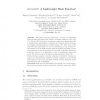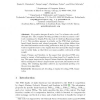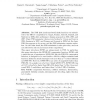IACR
2011
13 years 7 months ago
2011
We introduce a new concept in splice-and-cut attacks on hash functions, which bridges the gap between preimage attacks and a powerful method of differential cryptanalysis. The ne...
IACR
2011
13 years 7 months ago
2011
We present the hash-based signature scheme XMSS. It is the first provably (forward) secure and practical signature scheme with minimal security requirements: a pseudorandom and a ...
CRYPTO
2011
Springer
13 years 7 months ago
2011
Springer
RFID security is currently one of the major challenges cryptography has to face, often solved by protocols assuming that an on-tag hash function is available. In this article we pr...
CRYPTO
2011
Springer
13 years 7 months ago
2011
Springer
We prove that Tandem-DM, one of the two “classical” schemes for turning a blockcipher of 2n-bit key into a double block length hash function, has birthday-type collision resist...
124
click to vote
CHES
2011
Springer
13 years 7 months ago
2011
Springer
This paper proposes spongent – a family of lightweight hash functions with hash sizes of 88 (for preimage resistance only), 128, 160, 224, and 256 bits based on a sponge construc...
100
click to vote
CODCRY
2011
Springer
13 years 11 months ago
2011
Springer
Fix positive integers B and w. Let C be a linear code over F2 of length Bw. The 2-regular-decoding problem is to find a nonzero codeword consisting of w length-B blocks, each of w...
146
click to vote
AFRICACRYPT
2011
Springer
13 years 11 months ago
2011
Springer
Abstract. The FSB (fast syndrome-based) hash function was submitted to the SHA-3 competition by Augot, Finiasz, Gaborit, Manuel, and Sendrier in 2008, after preliminary designs pro...
TISSEC
2010
14 years 2 months ago
2010
We revisit the problem of constructing a protocol for performing authenticated encryption with associated data (AEAD). A technique is described which combines a collision resistant...
CRYPTO
2010
Springer
14 years 4 months ago
2010
Springer
We show that the widely deployed RSA-OAEP encryption scheme of Bellare and Rogaway (Eurocrypt 1994), which combines RSA with two rounds of an underlying Feistel network whose hash...
ICC
2009
IEEE
14 years 5 months ago
2009
IEEE
Cryptographic hash functions are often built on block ciphers in order to reduce the security of the hash to that of the cipher, and to minimize the hardware size. Proven secure co...




